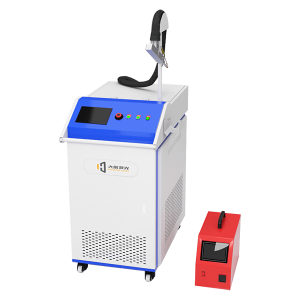How to deal with the weld defects produced by laser welding machine welding
There are various kinds of defects in laser welding welds, including weld porosity caused by the absorption of gas by the weld; cracks caused by organisational and thermal stresses; and unevenness of the joint surface and distortion and deformation due to insufficient matching accuracy of the parts. Today we will only discuss porosity and cracks.
(1) Porosity Porosity is caused by the weld metal trapping gas in the solidification process. The cooling rate of the weld metal during laser welding is much faster than conventional welding, so the gas is not easy to escape from the weld, trapped in the weld to form pores.
Laser welding machine welding porosity formation causes are as follows:
l) the material itself contains a certain amount of gas, for example, steel usually contains oxygen or other gases left over from steelmaking.
2) The strong vaporisation of low melting point metals, such as zinc in the surface layer of galvanised steel or the vaporisation of certain elements in the base material.
3) Air entering the molten pool.
4)Entry of oil, rust, moisture and paint on the surface of the weldment.
Obviously, the high purity of the base material, the suitable form of joint, the correct use of shielding gas and the cleaning of the surface of the weldment before welding are self-interested in reducing weld porosity. Appearance of spherical, less than 0.2mm in diameter smaller pores in the general weld often appear, the number of small does not necessarily constitute a hazard, but the number of more will make the weld load area is reduced, reducing the tensile strength of the weld. When the pores are evenly distributed, the degree of harm will be less. Hydrogen is a harmful gas in steel, because the welding speed of laser welding is faster, so less favourable for hydrogen to escape from the weld. The weld gas is more difficult to be discharged when deep fusion welding, and it is easy to have gas holes. If the use of penetrating melting laser welding, low welding speed and post-welding heat treatment methods, can reduce weld porosity.
2) Crystalline cracking Crystalline cracking usually occurs at temperatures above the solid phase line of the alloy. Laser welding weld in the molten metal in the liquid a solid phase line between the crystallisation and growth, the metal from liquid to solid transition will occur volume contraction, resulting in contraction stress and lead to cracks, the generation of its site is usually the weld's final solidification zone. Generally speaking, the liquid metal of the laser welding weld is more difficult to solidify fully, so the bottom force is usually larger than the general welding, the tendency to form cracks is also larger. For steel materials, half-molten zone in the solid state organisation contains a large amount of austenite, laser weld cooling rate is fast enough to make the austenite into martensite, this organisational stress will increase the tendency to crack. Cracks often originate in low melting point eutectic. The s, P and B elements in the laser welding machine weld will increase the tendency of crack formation, and the addition of appropriate amounts of Mn can inhibit crack generation. In addition, laser welding machine weldments with precision, reduce stress concentration of reasonable joint design, as well as the use of pre-welding or post-welding heat treatment, etc., can also be received to reduce the effect of cracking.


